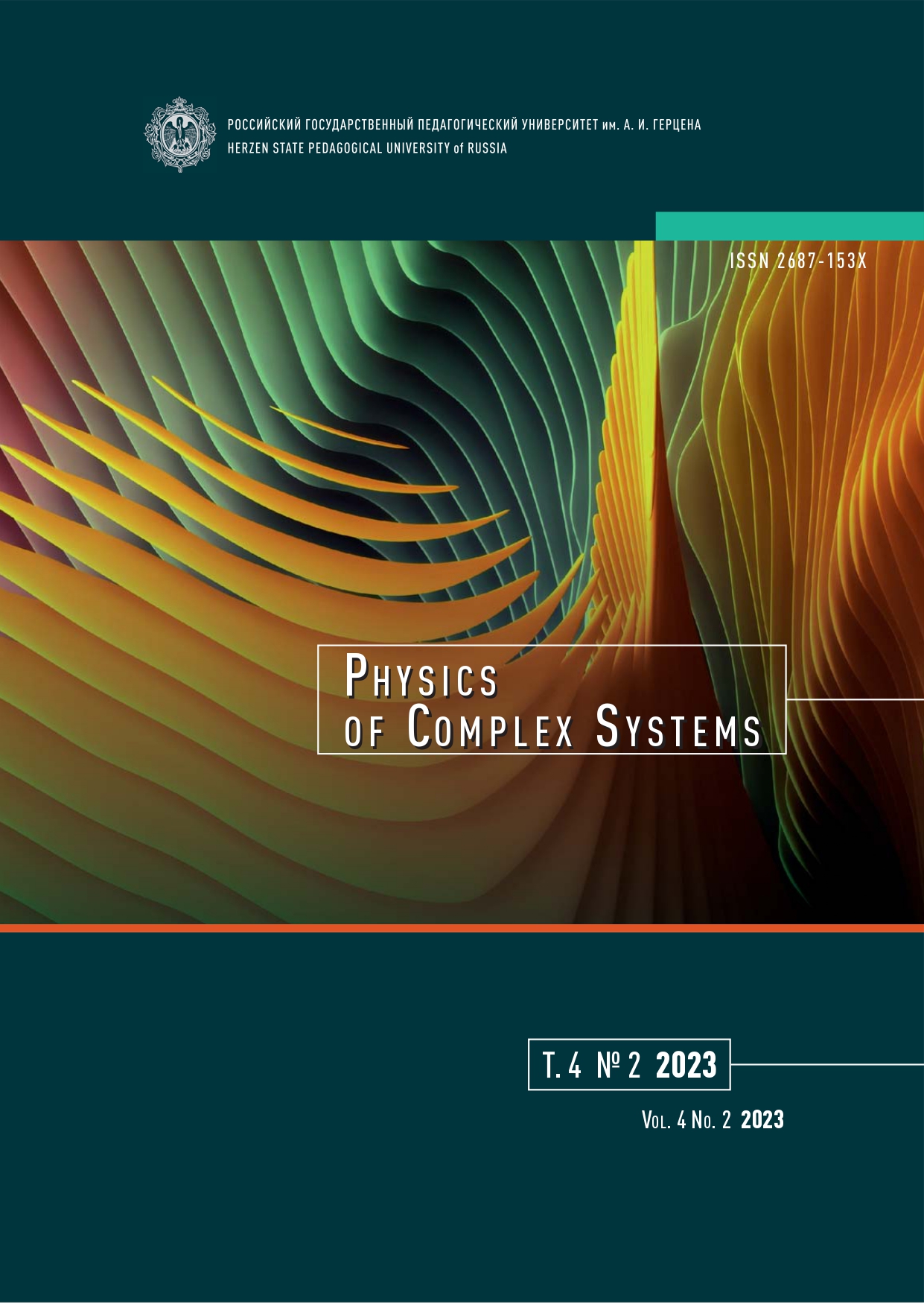On the temperature of hairy black holes
DOI:
https://doi.org/10.33910/2687-153X-2023-4-2-59-67Keywords:
hairy black hole, Hawking temperature, charged black hole, gravitational decoupling, Einstein’s equationsAbstract
The gravitational decoupling method represents an extremely useful tool to obtain new solutions of the Einstein equations through minimal geometrical deformations. In this paper, we consider a hairy charged black hole obtained by the gravitational decoupling and calculate its Hawking temperature in order to compare it with the case when the hairs are ignored. We have found out that the hair, under some conditions of black hole parameters, affect the Hawking temperature and can increase it. We have also found out that the black hole temperature, in the hairy case, does not depend on the electric charge.
References
Banados, M., Silk, J., West, S. M. (2009) Kerr black holes as particle accelerators to arbitrarily high energy. Physical Review Letters, 103 (11), article 111102. https://doi.org/10.1103/PhysRevLett.103.111102 (In English)
Brown, J. D., Creighton, J., Mann, R. B. (1994) Temperature, energy, and heat capacity of asymptotically anti–de Sitter black holes. Physical Review D, 50 (10), article 6394. https://doi.org/10.1103/PhysRevD.50.6394 (In English)
Carlip, S. (2009) Black hole thermodynamics and statistical mechanics. Lecture Notes in Physics, 769, 89–123. https://doi.org/10.1007/978-3-540-88460-6_3 (In English)
Cavalcanti, R. T., Alves, K. D. S., Hoff da Silva, J. M. (2022). Near-horizon thermodynamics of hairy black holes from gravitational decoupling. Universe, 8 (7), article 363. https://doi.org/10.3390/universe8070363 (In English)
Contreras, E., Ovalle, J., Casadio, R. (2021) Gravitational decoupling for axially symmetric systems and rotating black holes. Physical Review D, 103 (4), article 044020. https://doi.org/10.1103/PhysRevD.103.044020 (In English)
Gibbons, G. W., Hawking, S. W. (1977) Action integrals and partition functions in quantum gravity. Physical Review D, 15 (10), article 2752. https://doi.org/10.1103/PhysRevD.15.2752 (In English)
Grib, A. A., Pavlov, Yu. V. (2015) Are black holes totally black? Gravitation and Cosmology, 21 (1), 13–18. https://doi.org/10.1134/S0202289315010065 (In English)
Grib, A. A., Pavlov, Yu. V. (2022) On phase transitions near black holes. JETP Letters, 116 (8), 493–499. https://doi.org/10.1134/S0021364022601907 (In English)
Hawking, S. W. (1975) Particle creation by black holes. Communications in Mathematical Physics, 43 (3), 199–220. https://doi.org/10.1007/BF02345020 (In English)
Hawking, S. W., Perry, M. J., Strominger, A. (2016) Soft hair on black holes. Physical Review Letters, 116 (23), article 231301. https://doi.org/10.1103/PhysRevLett.116.231301 (In English)
Mahapatra, S., Banerjee, I. (2023) Rotating hairy black holes and thermodynamics from gravitational decoupling. Physics of the Dark Universe, 39, article 101172. https://doi.org/10.1016/j.dark.2023.101172 (In English)
Ovalle, J. (2017) Decoupling gravitational sources in general relativity: From perfect to anisotropic fluids. Physical Review D, 95 (10), article 104019. https://doi.org/10.1103/PhysRevD.95.104019 (In English)
Ovalle, J., Casadio, R., Contreras, E., Sotomayor, A. (2021) Hairy black holes by gravitational decoupling. Physics of the Dark Universe, 31, article 100744. https://doi.org/10.1016/j.dark.2020.100744 (In English)
Ovalle, J., Casadio, R., da Rocha, R. et al. (2018) Black holes by gravitational decoupling. The European Physical Journal C, 78, article 960. https://doi.org/10.1140/epjc/s10052-018-6450-4 (In English)
Poisson, E. (2007) A relativist’s toolkit: The mathematics of black-hole mechanics. Cammbridge: Cambridge University Publ., 233 p. (In English)
Ramos, A., Arias, C., Avalos, R., Contreras, E. (2021) Geodesic motion around hairy black holes. Annals of Physics, 431, article 168557. https://doi.org/10.1016/j.aop.2021.168557 (In English)
Vagnozzi, S., Rittick, R., Yu-Dai, T. et al. (2022) Horizon-scale tests of gravity theories and fundamental physics from the Event Horizon Telescope image of Sagittarius A*. arXiv, article 2205.07787. [Online]. Available at: https://doi.org/10.48550/arXiv.2205.07787 (accessed 10.03.2023). (In English)
Vertogradov, V. (2022). On the particle collisions during gravitational collapse of Vaidya spacetimes. arXiv:2211.16189. [Online]. Available at: https://doi.org/10.48550/arXiv.2211.16189 (accessed 17.01.2023). (In English)
Vertogradov, V., Misyura, M. (2022) Vaidya and generalized vaidya solutions by gravitational decoupling. Universe, 8 (11), article 567. https://doi.org/10.3390/universe8110567 (In English)
Visser, M. (1992) Dirty black holes: Thermodynamics and horizon structure. Physical Review D, 46 (6), article 2445. https://doi.org/10.1103/PhysRevD.46.2445 (In English)
Zaslavskii, O. B. (2012) Acceleration of particles by black holes as a result of deceleration: Ultimate manifestation of kinematic nature of BSW effect. Physics Letters B, 712 (3), 161–164. https://doi.org/10.1016/j.physletb.2012.05.009 (In English)
Downloads
Published
Issue
Section
License
Copyright (c) 2023 Vitalii D. Vertogradov, Dmitriy A. Kudryavtsev

This work is licensed under a Creative Commons Attribution-NonCommercial 4.0 International License.
The work is provided under the terms of the Public Offer and of Creative Commons public license Creative Commons Attribution 4.0 International (CC BY 4.0).
This license permits an unlimited number of users to copy and redistribute the material in any medium or format, and to remix, transform, and build upon the material for any purpose, including commercial use.
This license retains copyright for the authors but allows others to freely distribute, use, and adapt the work, on the mandatory condition that appropriate credit is given. Users must provide a correct link to the original publication in our journal, cite the authors' names, and indicate if any changes were made.
Copyright remains with the authors. The CC BY 4.0 license does not transfer rights to third parties but rather grants users prior permission for use, provided the attribution condition is met. Any use of the work will be governed by the terms of this license.







